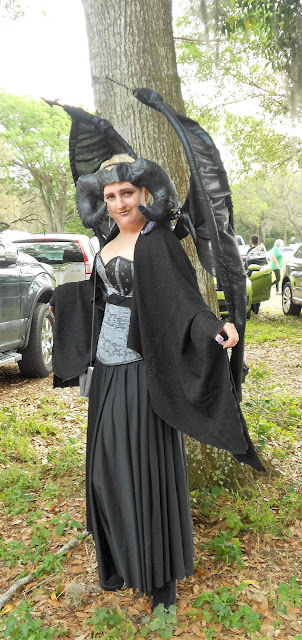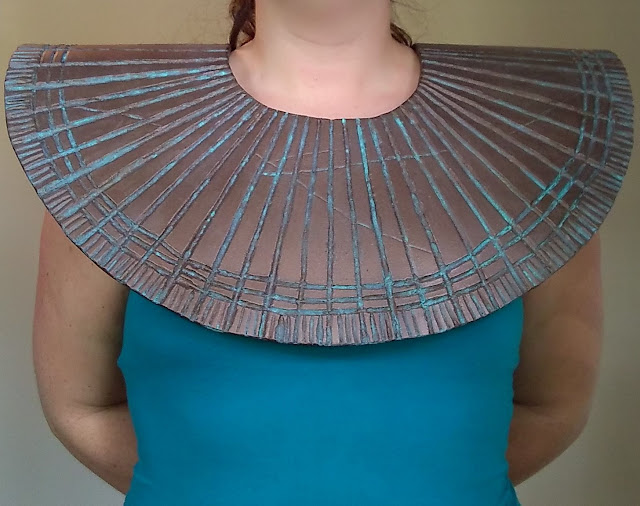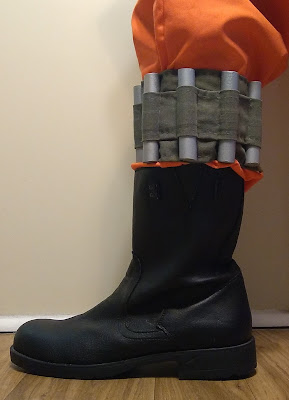Making Dragon Wings
How to Make Dragon Wings (big, cheap, and light-weight)
I've always loved wings, from bird wings to insect wings to bat wings (or angel, fairy, and dragon wings, depending on your interests). So for this year's medieval faire, I decided to try making my own! In general, I've found that the wings you can buy in costume stores are small and flimsy (personally, I'm not really moved by "sexy vampire wings," but maybe that's just me). And if you can find large wings, they're hideously expensive.
I spent some time thinking about the important components of the big three types of wings (angel, fairy, and dragon), and decided that dragon was the way to go this time. I love them all, but angel wings seemed a little more difficult for a beginner, and fairy wings weren't peaking my interest at the time. If you're looking for other resources on building large wings, I would recommend HCC Cosplay (http://whatishcc.com/tutorials/angel-wings/), whose tutorial was invaluable to me, especially when making the harness. So, without further ado, this is how I made my wings!
What you need:
- (2) 10-foot lengths of 1/2 inch diameter PVC (available from any big hardware store, generally for $2-3 each)
- (1) large plastic platter (good and thick, like a decorative plate or hard plastic clipboard. Mine was a dollar from a dollar store)
- 2 feet of a larger diameter PVC, big enough to holster the smaller 1/2 inch PVC
- 2+ yards of 1-2 inch wide nylon webbing (for the straps)
-A couple of assorted fasteners for the straps (I ended up using two strap adjusters and one parachute buckle)
-1-inch thick foam (enough to cover the finished harness plate)
-seam tape
-needle and thread
- Assorted bolts (both long and short), nuts, and wood screws
-a couple gewgaws for decoration
-For tools, I mostly used a dremel and a heat gun, although a regular electric drill came in handy as well. You can do it without those, but it'll take longer and be more annoying. At the very least you need a hacksaw to cut the pipe, and some sand and a working oven to bend it (the method of pouring very hot sand into pvc to heat it up until you can mold it is totally doable, and I've done it before, but it is long and annoying. Also, note that a hair dryer is not a heat gun. Or, I guess it technically is, but it ain't gonna cut it here).
Steps:
1) Making the Wing Plate
Starbat's Note: So the plate that forms the base of the harness in most of these pictures is the one made from plastic. It did great up until a point, at which it snapped in half and I was forced to manufacture a new plate from plywood. Either one can work (or you could splurge on some aluminum or carbon fiber) but I would suggest trying to reinforce the plate or balance the load some way. With the plywood plate, we used washers to distribute the load for the four bolts that connected the wings to the plate.
HCC Cosplay suggests that you make the whole harness before actually making the wings, and this seems like sound advice to me. To begin, I took an ugly plastic decorative plate (nice and thick, remember that this is going to be the anchor of the whole shebang), and cut it to the shape and size you want it. I just cut the lip off the plate to make it flat.
Now cut the larger diameter PVC pipe in half, giving you two foot-length pieces. (Because of what I had left over from another project, I actually used four small pieces of larger-diameter PVC)
Bolt the pieces to the plate parallel to each other. These will form a holster for the actual wing structure to go into. Make sure that nothing protrudes far enough into the interior of the pipes that the smaller diameter PVC can't fit inside as well.
Put a length of the 1/2 inch PVC into each larger piece. These will form the major arc of each wing, so cut each length accordingly before putting it into the plate. I had the guys at Home Depot cut each 10-foot piece of PVC in half, so that I could get them into the car in the first place.
Using the dremel or the electric drill, drill a hole straight through both larger diameter pieces, including the smaller diameter PVC inside, so that a long bolt can pass through all the pieces at once. This will lock the wings into the harness while making it possible take the wings out again, making the whole thing able to disassemble for car rides.
If you're worried about making the wings stable, put another bolt through the two pieces a couple inches below the first one.
2) Forming the Wings
This is where you're going to need the heat gun. For my wings, I had three major "bones" in each of my wings, including the initial arch from the back plate, the outward arch at an angle from that bone, and a smaller bone paralleling the outward arch to give the wings some depth. However, in order to get all of those bones to connect, I had to cut up the upward arch into three sections and insert PVC tee joints.
Once you've got the joints in order, it's time to pull out your trusty heat gun to mold the PVC into a wing. I chose to do everything in sections and then reconnect them and do the final fittings. Honestly, the tricky part is getting everything symmetrical on both sides. The heat gun takes a while to heat the PVC to a pliable point, so don't be discouraged if seems be taking forever.
Note: DO NOT keep the heat gun pointed at a specific point for too long. The PVC will discolor, bubble, and burn. Just like using a hairdryer, always keep it moving.
From there, I quickly discovered that although I could use the tee joints to put the wing bones into position, the weight of all those pieces of PVC means the joints tend to wiggle around on their own, and can drop the outward arches of the sockets. To counteract that, I drilled holes at each join and put a wood screw in each hole. This attached all the bones in the position I wanted, and it's easy enough to unscrew the screws and take the wings apart again.
3) Assembling the Harness
You may have noticed that the harness above didn't have any straps or anything that would allow me to actually wear the wings. Which wasn't really that hard, but I really hated doing it and I agonized for ages about how to do it. In the end, I went for a simple backpack style.
First of all, I drilled four holes in the plate, each long enough to thread a 1-inch nylon webbing strap through.
After that, I took a 2-yard piece of nylon webbing strapping and cut it into 4 pieces of equal length (I burned the cut ends to stabilize them). In order to have adjustable straps, I used strap adjusters to reattach the pieces.
Anyway, once you have your two straps, each with an adjuster, you can attach them to the harness plate. This is pretty basic, just thread the strap through the hole, fold it back on itself, and sew it down. Repeat with each hole so you get two backpack-style straps.
I ended up also making a strap to pass around my chest and through the wing-pipes on the harness to act as a stabilizer for the wings. It's not that they're particularly heavy, but they can be unwieldy, especially in the wind.
To finish off the harness, I took a piece of foam (it started out life as a 1-inch thick seat cushion), and attached it to the underside of the plate. This kept the plate from rubbing against my back while it was seated. I chose to attach it by not gluing it down, but rather cutting it to fit, and then lacing some excess fabric in place over the foam and the plate.
4) Covering the Wings
A few months back, I found some fabric on sale at Hobby Lobby that just screamed dragon to me, so I picked up a 2-3 yards of it. It's a very thin fabric, semi-transparent in the sun, with small reflective flecks all over it, which suggested tiny scales to me.
For the wings, I decided to go ahead and just drape the whole swath of fabric over the wings to see how the size was.
And I used pins to mark out where the PVC bones were, so that I could make channels for them in the fabric
The trick was in trying to make the fabric cover removable, in order to preserve my ability to take the whole shebang apart in the future. This meant that I sewed channels for both the outward arches, but I ended up using a seam tape (double-sided fabric tape. Tough, but not permanent) on the upward arch.
After that was done, I went ahead and cut the two wings apart and saved the excess fabric for... reasons.
5) Decoration
I didn't mess with a lot of decoration (that may come later, but I want to make it so that I can use these wings again for another costume in the future), but I did spend a little time working on the talons.
I tried wrapping the "talons" on the end of each wing bone with a little of the same faux leather that I used to make the horns, but that looked awful. So instead, I took some neat finials from a thrift store curtain rod and glued those onto the top talon area (where I used to have a separate PVC bone).
And then just for the hell of it, I disassembled one of my belly dancer hand claw things:
and put the claws on the ends of each of the outward arch bones
From there, it's just trying everything out and shifting it around to be comfortable for you.
I've always loved wings, from bird wings to insect wings to bat wings (or angel, fairy, and dragon wings, depending on your interests). So for this year's medieval faire, I decided to try making my own! In general, I've found that the wings you can buy in costume stores are small and flimsy (personally, I'm not really moved by "sexy vampire wings," but maybe that's just me). And if you can find large wings, they're hideously expensive.
I spent some time thinking about the important components of the big three types of wings (angel, fairy, and dragon), and decided that dragon was the way to go this time. I love them all, but angel wings seemed a little more difficult for a beginner, and fairy wings weren't peaking my interest at the time. If you're looking for other resources on building large wings, I would recommend HCC Cosplay (http://whatishcc.com/tutorials/angel-wings/), whose tutorial was invaluable to me, especially when making the harness. So, without further ado, this is how I made my wings!
What you need:
- (2) 10-foot lengths of 1/2 inch diameter PVC (available from any big hardware store, generally for $2-3 each)
- (1) large plastic platter (good and thick, like a decorative plate or hard plastic clipboard. Mine was a dollar from a dollar store)
- 2 feet of a larger diameter PVC, big enough to holster the smaller 1/2 inch PVC
- 2+ yards of 1-2 inch wide nylon webbing (for the straps)
-A couple of assorted fasteners for the straps (I ended up using two strap adjusters and one parachute buckle)
-1-inch thick foam (enough to cover the finished harness plate)
-seam tape
-needle and thread
- Assorted bolts (both long and short), nuts, and wood screws
-a couple gewgaws for decoration
-For tools, I mostly used a dremel and a heat gun, although a regular electric drill came in handy as well. You can do it without those, but it'll take longer and be more annoying. At the very least you need a hacksaw to cut the pipe, and some sand and a working oven to bend it (the method of pouring very hot sand into pvc to heat it up until you can mold it is totally doable, and I've done it before, but it is long and annoying. Also, note that a hair dryer is not a heat gun. Or, I guess it technically is, but it ain't gonna cut it here).
Steps:
1) Making the Wing Plate
Starbat's Note: So the plate that forms the base of the harness in most of these pictures is the one made from plastic. It did great up until a point, at which it snapped in half and I was forced to manufacture a new plate from plywood. Either one can work (or you could splurge on some aluminum or carbon fiber) but I would suggest trying to reinforce the plate or balance the load some way. With the plywood plate, we used washers to distribute the load for the four bolts that connected the wings to the plate.
HCC Cosplay suggests that you make the whole harness before actually making the wings, and this seems like sound advice to me. To begin, I took an ugly plastic decorative plate (nice and thick, remember that this is going to be the anchor of the whole shebang), and cut it to the shape and size you want it. I just cut the lip off the plate to make it flat.
 |
| This is the current configuration, just in case the instructions leave you confused because my knowledge of technical terms is often limited to "that thing" and "doohickey" |
Now cut the larger diameter PVC pipe in half, giving you two foot-length pieces. (Because of what I had left over from another project, I actually used four small pieces of larger-diameter PVC)
Bolt the pieces to the plate parallel to each other. These will form a holster for the actual wing structure to go into. Make sure that nothing protrudes far enough into the interior of the pipes that the smaller diameter PVC can't fit inside as well.
Put a length of the 1/2 inch PVC into each larger piece. These will form the major arc of each wing, so cut each length accordingly before putting it into the plate. I had the guys at Home Depot cut each 10-foot piece of PVC in half, so that I could get them into the car in the first place.
Using the dremel or the electric drill, drill a hole straight through both larger diameter pieces, including the smaller diameter PVC inside, so that a long bolt can pass through all the pieces at once. This will lock the wings into the harness while making it possible take the wings out again, making the whole thing able to disassemble for car rides.
If you're worried about making the wings stable, put another bolt through the two pieces a couple inches below the first one.
2) Forming the Wings
This is where you're going to need the heat gun. For my wings, I had three major "bones" in each of my wings, including the initial arch from the back plate, the outward arch at an angle from that bone, and a smaller bone paralleling the outward arch to give the wings some depth. However, in order to get all of those bones to connect, I had to cut up the upward arch into three sections and insert PVC tee joints.
 |
| These are the wings, sans covering, but after heat gun treatment |
 |
| Welcome to my porch |
Once you've got the joints in order, it's time to pull out your trusty heat gun to mold the PVC into a wing. I chose to do everything in sections and then reconnect them and do the final fittings. Honestly, the tricky part is getting everything symmetrical on both sides. The heat gun takes a while to heat the PVC to a pliable point, so don't be discouraged if seems be taking forever.
Note: DO NOT keep the heat gun pointed at a specific point for too long. The PVC will discolor, bubble, and burn. Just like using a hairdryer, always keep it moving.
From there, I quickly discovered that although I could use the tee joints to put the wing bones into position, the weight of all those pieces of PVC means the joints tend to wiggle around on their own, and can drop the outward arches of the sockets. To counteract that, I drilled holes at each join and put a wood screw in each hole. This attached all the bones in the position I wanted, and it's easy enough to unscrew the screws and take the wings apart again.
3) Assembling the Harness
You may have noticed that the harness above didn't have any straps or anything that would allow me to actually wear the wings. Which wasn't really that hard, but I really hated doing it and I agonized for ages about how to do it. In the end, I went for a simple backpack style.
First of all, I drilled four holes in the plate, each long enough to thread a 1-inch nylon webbing strap through.
After that, I took a 2-yard piece of nylon webbing strapping and cut it into 4 pieces of equal length (I burned the cut ends to stabilize them). In order to have adjustable straps, I used strap adjusters to reattach the pieces.
 |
| Behold my terrible sewing ability. And my terrible photography. It's possible this whole "craft blog" thing isn't for me. |
Anyway, once you have your two straps, each with an adjuster, you can attach them to the harness plate. This is pretty basic, just thread the strap through the hole, fold it back on itself, and sew it down. Repeat with each hole so you get two backpack-style straps.
 |
| Here's the first strap on, along with a view of the underside of the harness plate. |
To finish off the harness, I took a piece of foam (it started out life as a 1-inch thick seat cushion), and attached it to the underside of the plate. This kept the plate from rubbing against my back while it was seated. I chose to attach it by not gluing it down, but rather cutting it to fit, and then lacing some excess fabric in place over the foam and the plate.
4) Covering the Wings
A few months back, I found some fabric on sale at Hobby Lobby that just screamed dragon to me, so I picked up a 2-3 yards of it. It's a very thin fabric, semi-transparent in the sun, with small reflective flecks all over it, which suggested tiny scales to me.
 |
| Look at that shimmer! |
For the wings, I decided to go ahead and just drape the whole swath of fabric over the wings to see how the size was.
 |
| Ignore the weird bulge, I still had the wings set up on the lawn chair |
And I used pins to mark out where the PVC bones were, so that I could make channels for them in the fabric
The trick was in trying to make the fabric cover removable, in order to preserve my ability to take the whole shebang apart in the future. This meant that I sewed channels for both the outward arches, but I ended up using a seam tape (double-sided fabric tape. Tough, but not permanent) on the upward arch.
After that was done, I went ahead and cut the two wings apart and saved the excess fabric for... reasons.
5) Decoration
I didn't mess with a lot of decoration (that may come later, but I want to make it so that I can use these wings again for another costume in the future), but I did spend a little time working on the talons.
I tried wrapping the "talons" on the end of each wing bone with a little of the same faux leather that I used to make the horns, but that looked awful. So instead, I took some neat finials from a thrift store curtain rod and glued those onto the top talon area (where I used to have a separate PVC bone).
And then just for the hell of it, I disassembled one of my belly dancer hand claw things:
and put the claws on the ends of each of the outward arch bones
From there, it's just trying everything out and shifting it around to be comfortable for you.












Comments
Post a Comment